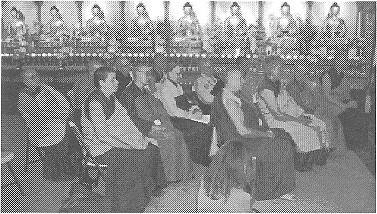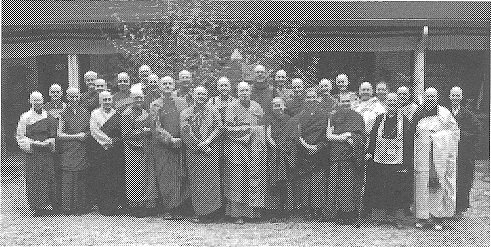|

今年第十屆西方佛教僧團會議,在加州靠近聖塔‧庫魯茲的「藥師佛土」舉行,藏、中、泰、越與日本的卅位僧侶,代表南傳、北傳、與藏傳佛教出席此會。隨著僧團在北美日益成長,這是在北美出家人舉辦的第十屆會議。
今年會議的主題是「淡泊與棄捨」,籌備人恆實法師和駱參‧齋梅主持每日的講演與座談會。下午與會大眾到艾波特斯的懸崖海灘施淨水「施食普雷特斯」(或稱餓鬼)和在海邊受苦的眾生。
第二天是農曆十五,來自不同教派的出家眾齊心誦戒,此儀式使宗派和不同顏色袈裟的障礙消失於無形。當滿月東升之時,比丘們在山頂上諷誦波羅提木叉。
會議最精彩的部份是一位藏傳仁波切,敘述他幾十年來在西藏被拘禁時閉關修行的經驗。
主講的法師談他們個人相關的經驗,例如:托缽、持戒、順應西方文化、在僧團中如何做決策和解決衝突、防止過勞、群居對獨居等項。在五位主講者演說後,與會者分成小組,就各主題,進行更詳細的討論。越南禪師庫沙喇談到他為何要受戒:「家庭是大苦因;獨身易知足。家庭需要金錢和注意力來維持。而出家,使我將潛在的淫欲拋下。一個關係中必然有二者:一女、一男;而獨身,使這個遊戲場平等。在獨身主義中,在日常生活中,我們可以看到淫欲之升起及對治的方法。」
庫沙喇禪師常在洛杉磯的少年感化院教化年輕人。他說:「我用他們能懂的話語來溝通;離開前,我會拿出口琴吹幾首布魯思(藍調)歌曲,幾首他們可以聽得進去的歌。」
出家已卅五年的漢傳大乘比丘尼,恆持法師,問及僧團之決事權及行政:有的使用共識模式,有的使用官階式,有的則用民主模式。僧團一天天成長,如何做和諧決策,這一需要變得更富挑戰性。一旦嘗試融匯佛教諸宗,一個全新的困難面也跟著浮現。
「夏思塔寺」的宓安法師對工作與修行間的平衡、如何簡化生活,或者至少在環境複雜性中,保持一顆單純的心提供了他的看法。在過去幾年裡,「夏思塔寺」僧人在夏思塔山當地的鎮上開始托缽,並且已轉為完全靠信施檀越的供養。「我們不得索取食物;所以我們走得很快,也許太快了!但是人們會供養,也樂見有布施的機會。我們要做到的是,做世人的福田。」
一位南傳法師羅喉羅住在西維吉尼亞州的巴梵那中心,談及如何以單純的心在複雜環境中度日。泰國叢林的阿姜維拉達模甚欣賞早年他在泰國的純樸日子。「我以前住在雨林中,對一個芒果的貪心,到了很離譜又荒唐的地步,真難為情。因為貪心沒有其他宣泄之途徑,所以我的心完全集中在貪那個芒果上了。」
藏傳的比丘尼涂柏騰回憶出她對新道場奉獻的抱負,這個道場是位於北華盛頓州的「室羅筏寺」。「我總是發現自己處於複雜的狀況中;我剛出家未久,要面對一些事情,原本以為我是個沒火星的,沒想到一遇事,那火氣都上來了。」」「室羅筏寺」是在美國第一個藏傳的訓練中心,它全靠信眾的供養。
最廣泛討論的主題是──托缽乞食,特別是南傳「無畏寺」的法師們分享每週如何到瑜伽市托缽的情形。「夏思塔寺」比丘已經開始在夏思塔山鎮上定期托缽;而「格林顧爾趣禪農場」的休荷法師則定期在三藩市市區步行托缽。
許多僧眾,特別是藏傳,沒有居士的護持,都需工作以自給自足。宓安法師講了一位虔誠女法師的故事。她住在旅行車中,為了受戒,足足等待了卅年,並在沒有任何團體的護持之下,獨自完成一百天密集的戒期。
當年在印度,佛陀的僧團分裂成不同的派系,至今仍未統一。如今在北美,僧眾有如此的機會,可以解決累積的問題,並放下多世紀以來派系的包袱。如宣公禪師在邀請各宗派的出家人給新僧人傳戒時所說:現在北傳佛教不要再往北走,南傳佛教要回頭向中間走,法只有一個。
與會所有的出家眾將他們的戒臘加起來,發現大夥的戒臘總共是五百年。
|
|
The Tenth Annual Western Buddhist Monastic Conference was held this year at Land of Medicine Buddha, in Soquel, near Santa Cruz, California. Thirty monks and nuns from the Tibetan, Chinese, Thai, Vietnamese, and Japanese traditions represented Theravada, Mahayana, and Vajrayana Buddhist schools. This gathering marked the tenth anniversary of the North American Monastic Sangha as it emerges in North America. The theme was Simplicity and Renunciation, and the organizers of the event, Reverend Heng Sure and Venerable Losang Drimay facilitated the daily councils and discussion groups that ensued. In the afternoon the group went to Seacliff Beach in Aptos to offer purified water to “Feed the Pretas,” or hungry ghosts and suffering beings at the ocean side.
Day two was a full moon day and the fully ordained monks and nuns from different traditions recited the Pratimoksha—their rules of training—together, thus dissolving barriers between lineage and robe color. The Bhikshus recited the Rules under the rising full moon on a hilltop above Land of Medicine Buddha.
One of the highlights of the gathering was a conversation with a senior Tibetan Lama Choden Rimpoche, who told of his decades of practice in seclusion while under house arrest in Tibet.
Keynote speakers related personal experiences of alms rounds, Vinaya practice and adaptation to Western culture, decision-making and conflict-resolution in the Sangha, avoiding burn out, living in community vs. living on one’s own, among others. Following each the five keynote talks, attendees met in smaller groups to discuss the topics in detail. Reverend Kusala of the Vietnamese Zen tradition spoke about his own reasons for ordaining. “Families cause much suffering, and being single leads to contentment. Families take money and focus. By leaving family behind I leave behind the potential for lust. In a relationship there has to be two, a girl and a guy. Celibacy levels the playing field. With celibacy you can see how lust arises daily; you can see how to control it.”
Reverend Kusala works with youth in several juvenile halls in the Los Angeles area. He says, “I talk to them in a language they can understand. And before I leave I pull out my harmonica and play the blues. It’s a sound they can relate to.”
Heng Ch’ih, a Bhikshuni with 35 years in robes ordained in the Chinese Mahayana tradition, questioned how the Sangha resolves issues of decision-making and administration: some use consensus, hierarchy, or democratic models. As the Sangha grows, the need to make decisions harmoniously becomes more challenging. A whole new level of difficulty arises when we attempt to combine Buddhist traditions.
Reverend Meian of Shasta Abbey offered reflections around balancing work and practice, and how to simplify life, or at least keep the mind simple in the midst of complexity. In the past few years, Shasta Abbey has begun doing alms round in the local town of Mt. Shasta, and has shifted their support base to relying completely on voluntary donations (dana). “We aren’t allowed to ask for food. We actually walk quite fast; maybe too fast! But people give offerings, and they appreciate the opportunity to give. That’s what we’re trying to be: a field of merit for the world.” Bhante Rahula, a Theravada monk living at Bhavana Society in West Virginia, talked about living with a simple mind in a more complicated environment.
Ajahn Viradhammo of the Thai Forest Tradition greatly appreciated the simplicity of his early days in Thailand. “While I was living in the forest the amount of greed I experienced over a simple mango was embarrassing—it was absurd and ridiculous. There weren’t multiple outlets for greed so the mind focused it all on a mango.”
Venerable Thubten Chodron, a nun of the Tibetan tradition, reflected on the aspiration to be devoted to her new center—Sravasti Abbey in northern Washington State. “I always found myself in complex situations. I was only a junior nun and was having to face things that brought out the anger in the mind, the anger I thought I didn’t have.” Sravasti Abbey is the first Tibetan training center of its kind in the U.S., and is run completely on a voluntary donation (dana) basis.

Alms rounds were discussed at length, particularly how the Theravada monks of Abhayagiri Monastery walk with their bowls once a week in the local city of Ukiah. The monks at Shasta Abbey have begun regular alms rounds in the town of Mt. Shasta. Reverend Shoho of Green Gulch Zen Farms walked regularly for alms in downtown San Francisco.
Many monastics, particularly in the Tibetan tradition, live on their own without a supporting lay community and have to work to support themselves. Reverend Meian told a story of a dedicated nun who lives in an RV. She waited 30 years to ordain and has completed a 100 day intensive session on her own, without community support.
The Buddha’s Sangha in India split into factions and schools and never returned into a unified community. Now in North America the opportunity exists to resolve the accumulated issues and set down the sectarian baggage carried for centuries. As Chan Master Hsuan Hua said when he invited monks of all traditions to join together to ordain new monastics: It’s time for the Northern School to stop moving to the North, and it’s time for the Southern tradition to turn around and meet in the Middle, where there is only one Dharma.”
The group tallied their collective years of ordination and discovered that as a group we had been in precept robes a total of 500 years.
|